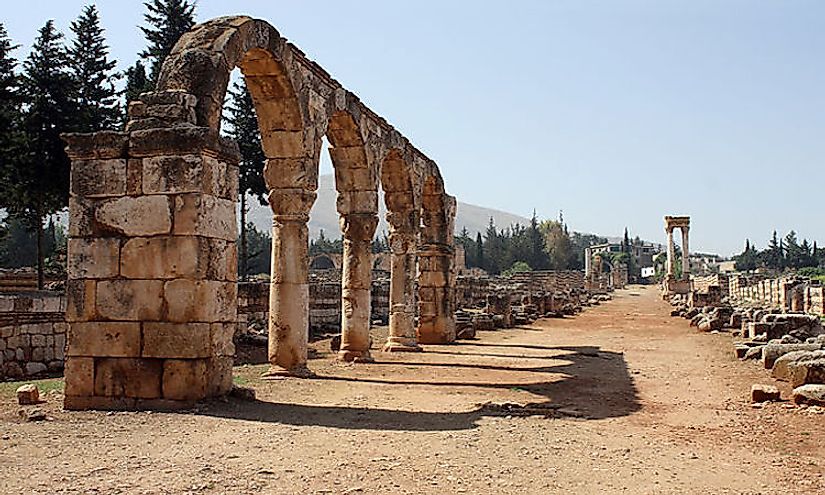UNESCO World Heritage Sites In Lebanon

The country of Lebanon is a small country located in Western Asia in the region of the Middle East and it borders the Mediterranean Sea. Lebanon currently has five United Nations Educational, Scientific and Cultural Organization (UNESCO) World Heritage Sites, four of which were designated in 1984 and the most recent one being added in 1998. This article will discuss a few of these UNESCO sites, the history, and current importance of these sites.
Some of Lebanon's UNESCO World Heritage Sites:
Anjar
Anjar was designated as a UNESCO World Heritage site in 1984 and is currently located in the District of Zahle that is part of the Beqaa Governorate in the center of the country near the border with Syria. The city of Anjar was established by the ruler of the Umayyad Caliphate (661-750), Caliph Al-Walid ibn Abd al-Malik (688-715), in the beginning of the 8th century. The city was located at an important inland crossroads for two major trade routes, one between Beirut and Damascus and the other from Bekaa to Tiberiade. The city was never fully completed as on 744 the Caliph Ibrahim ibn Al-Walid (?-750) was defeated in battle and abdicated, which left the city partially destroyed and abandoned by its population. The city was re-discovered by archaeologists at the end of the 1940's, and shortly later, several thousands of Armenian refugees were resettled near the ruins where they still live. Today the ruins of Anjar are important because they show how a city was planned and built under the Umayyads and it helps to understand more about their civilization. The city also shows the region's transition to Islamic art and construction.
Tyre
Tyre was designated as a UNESCO World Heritage site in 1984 and is currently located in the City and District of Tyre that is part of the Governorate of South Lebanon in the southern part of the country. Tyre, one of the oldest cities in the world and its history goes back to 8,000 BC, although the generally accepted date for the founding of the city is 2750 BC. According to legend, the city is the birthplace of the mythical Europa and the first queen and founder of Carthage Dido. Tyre was a great city under the Phoenicians (1500-539 BC) and allowed them to rule over the seas and found colonies in the Mediterranean. The Achaemenid Empire (550-330 BC) conquered the city from the Phoenicians in 539 BC and ruled it until Alexander the Great (356-323) sacked the city in 332. Following Alexander's death, the city was ruled by the Antigonid dynasty (306-168) and then the Seleucid Empire (312-63 BC). In 126 BC the city became independent from the Seleucid Empire and in 64 BC became a Roman province. During the Crusades, the city was captured in 1124 AD and became one of the most important cities in the Kingdom of Jerusalem (1099-1291) as a trading center and seat of the kingdom until 1191. In 1291 the city was captured by the Mamluk Sultanate (1250-1517) who ruled it until the Ottoman Empire (1299-1923) took control of the city. The city's historical role as a major city and trading center decline ones the Crusades ended in 1291 and never recovered. Currently, the city is for its long history over various stages of humanity and the importance it has had for various civilizations.
Ouadi Qadisha and Horsh Arz el-Rab
The Ouadi Qadisha and Horsh Arz el-Rab (Holy Valley and Forest of the Cedars of God) was designated as a UNESCO World Heritage Site in 1998. It is currently located in the Qadisha Valley that is in the Becharre District, which is part of the Governorate of North Lebanon. The site is made up of three different parts Ouadi Qadisha, Qadisha Valley, and the Forest of the Cedars of God. Ouadi Qadisha is the site of some of the first Christian monasteries on Earth, and there have been more that have been built since then, as they range from being built in the late 4th century up until the 14th century. The Qadisha Valley is located at the bottom of Mount al-Makmel and has the Holy River Qadisha running through it.
The Threats To Lebanon's UNESCO World Heritage Sites
The site at the ruins of Anjar needs to incorporate some of the parts of the ruins that are on the outskirts of the site's buffer zone. During so would also help to protected the site's visual integrity as well as helping to limit any modern construction that could happen in the area. Besides this issue the site is well maintained having undergone major restoration and is properly and regular maintain and taken care off. Tyre faces several different threats that threaten the property like groups transport infrastructure, housing, the impacts of the tourism industry and insufficient maintenance in the older buildings. The site is also in need of a management plan to govern the site. The Ouadi Qadisha and Horsh Arz el-Rab site has a number of threats facing it, including from housing, illegal activities in the area, the impact that tourism has on the site, livestock grazing and farming on the site and a lack of major visitor accommodations and a site management plan.
UNESCO World Heritage Sites In Lebanon
| UNESCO World Heritage Sites in Lebanon | Year of Inscription; Type |
| Anjar | 1984; Cultural |
| Baalbek | 1984; Cultural |
| Byblos | 1984; Cultural |
| Ouadi Qadisha and Horsh Arz el-Rab (Holy Valley and Forest of the Cedars of God) | 1998; Cultural |
| Tyre | 1984; Cultural |











